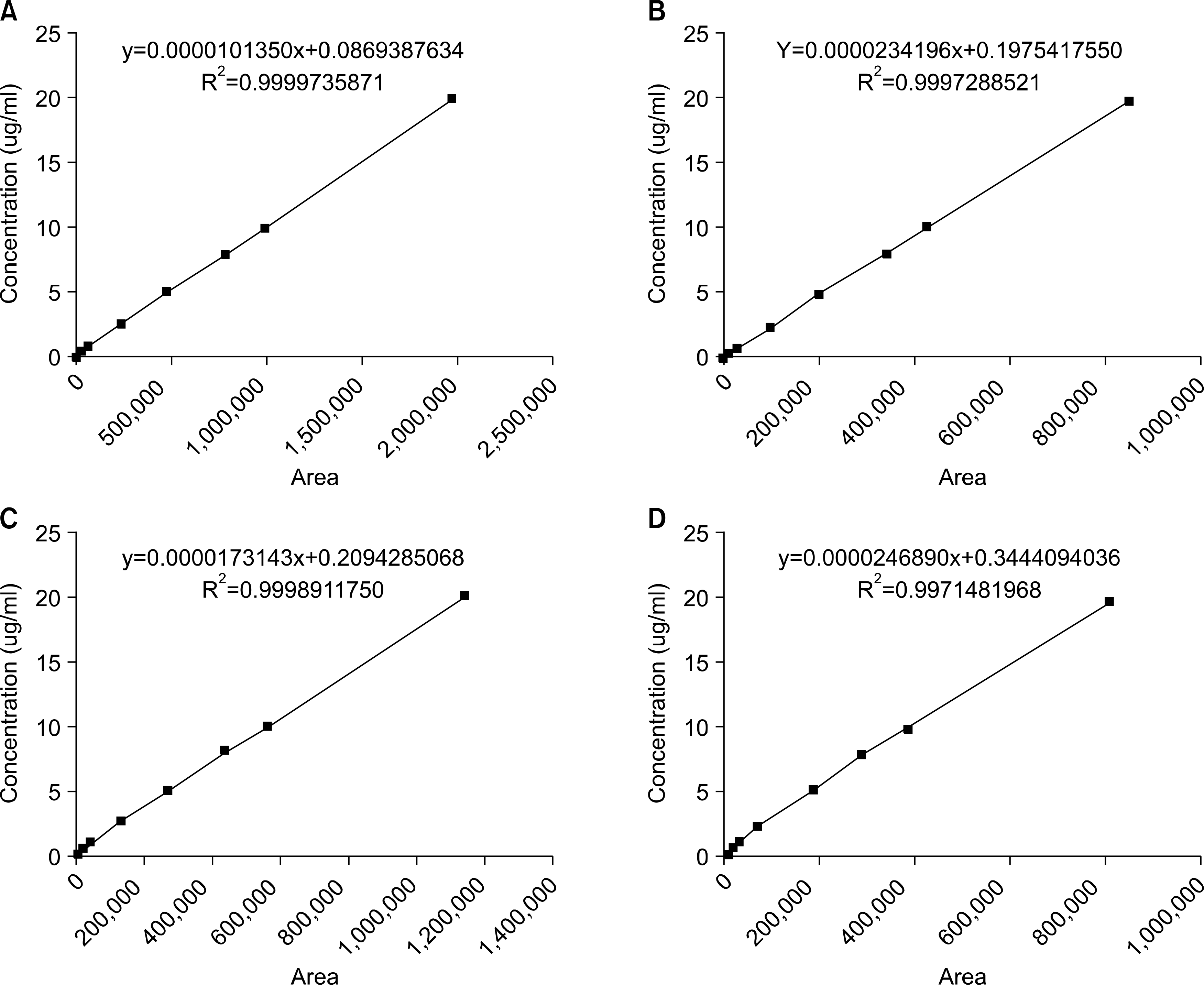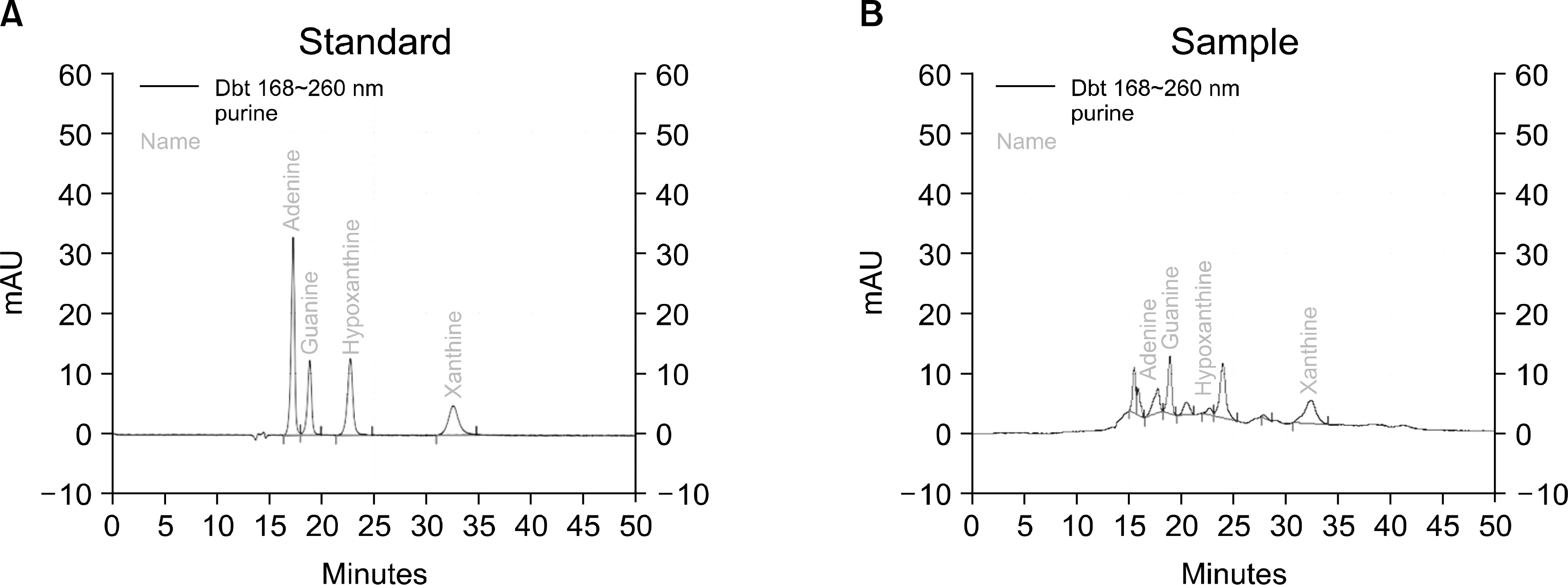Abstract
Objective
Gout is one of the most common forms of inflammatory arthritides among men, which is caused primarily by chronic hyperuricemia. Although pharmacological therapy is the mainstay treatment to manage gout, limiting the consumption of dietary purine is also important. Several epidemiological studies have reported that alcohol consumption is closely related to hyperuricemia and gout. The objective of this study was to determine the purine content in common Korean alcoholic beverages using high performance liquid chromatography (HPLC) to provide a dietary guideline for those with hyperuricemia or gout.
Methods
Thirty-five alcoholic beverages were analyzed. Blindly labeled samples of each alcoholic beverage were degassed and frozen. The sample preparation prior to HPLC followed the methods of Japanese researchers. HPLC was performed to analyze adenine, guanine, hypoxanthine, and xanthine content in the alcoholic beverages.
Results
The standard curves were linear for all purines. Purine contents were as follows: beer (42.26~146.39 μmol/L, n=12), medicinal wine (8.2 and 40.41 μmol/L, n=2), rice wine (13.19 μmol/L), Makgeolri (11.71 and 24.72 μmol/L, n=2), red wine (0, 6.03, and 17.9 μmol/L, n=3). No purines were found in fruit wine (n=2), Kaoliang (n=1), white wine (n=1), or distilled alcoholic beverages, such as soju (n=10) or whiskey (n=1).
Go to : 
REFERENCES
2). Saag KG., Choi H. Epidemiology, risk factors, and lifestyle modifications for gout. Arthritis Res Ther. 2006. ;8 (Suppl 1): S2.
3). Bieber JD., Terkeltaub RA. Gout: on the brink of novel therapeutic options for an ancient disease. Arthritis Rheum. 2004. 50:2400–14.

4). Neogi T., Hunter DJ., Chaisson CE., Allensworth-Davies D., Zhang Y. Frequency and predictors of inappropriate management of recurrent gout attacks in a longitudinal study. J Rheumatol. 2006. 33:104–9.
5). Zhang W., Doherty M., Bardin T., Pascual E., Barskova V., Conaghan P, et al. EULAR evidence based recommendations for gout. Part II: management. Report of a task force of the EULAR Standing Committee for International Clinical Studies Including Therapeutics (ESCISIT). Ann Rheum Dis. 2006. 65:1312–24.

6). Lieber CS., Jones DP., Losowsky MS., Davidson CS. Interrelation of uric acid and ethanol metabolism in man. J Clin Invest. 1962. 41:1863–70.

8). Choi HK., Atkinson K., Karlson EW., Willett W., Curhan G. Alcohol intake and risk of incident gout in men: a prospective study. Lancet. 2004. 363:1277–81.

9). Kaneko K., Yamamobe T., Fujimori S. Determination of purine contents of alcoholic beverages using high performance liquid chromatography. Biomed Chromatogr. 2009. 23:858–64.

10). Makkar HP., Becker K. Purine quantification in digesta from ruminants by spectrophotometric and HPLC methods. Br J Nutr. 1999. 81:107–12.

11). Puig JG., Fox IH. Ethanol-induced activation of adenine nucleotide turnover. Evidence for a role of acetate. J Clin Invest. 1984. 74:936–41.

12). Yamamoto T., Moriwaki Y., Takahashi S., Suda M., Higashino K. Effect of ethanol ingestion on nucleotides and glycolytic intermediates in erythrocytes and purine bases in plasma and urine: acetaldehydeinduced erythrocyte purine degradation. Metabolism. 1993. 42:1212–6.

13). Yamamoto T., Moriwaki Y., Takahashi S. Effect of ethanol on metabolism of purine bases (hypoxanthine, xanthine, and uric acid). Clin Chim Acta. 2005. 356:35–57.

14). Inokuchi T., Ka T., Yamamoto A., Moriwaki Y., Takahashi S., Tsutsumi Z, et al. Effect of ethanol on mono-sodium urate crystal-induced inflammation. Cytokine. 2008. 42:198–204.
15). Szabo G. Alcohol's contribution to compromised immunity. Alcohol Health Res World. 1997. 21:30–41.
16). Arbabi S., Garcia I., Bauer GJ., Maier RV. Alcohol (ethanol) inhibits IL-8 and TNF: role of the p38 pathway. J Immunol. 1999. 162:7441–5.
17). Gibson T., Rodgers AV., Simmonds HA., Toseland P. Beer drinking and its effect on uric acid. Br J Rheumatol. 1984. 23:203–9.

18). Gibson T., Rodgers AV., Simmonds HA., Court-Brown F., Todd E., Meilton V. A controlled study of diet in patients with gout. Ann Rheum Dis. 1983. 42:123–7.

19). Committee for the Preparation of Guidelines for the Management of Hyperuricemia and Gout.Lifestyle Guidance. Guidelines for the Management of Hyperuricemia and Gout. Tokyo, Japanese Society of Gout and Nucleic Acid Metabolism. 2002.
Go to : 
 | Fig. 2.Standard curves for for purine bases. (A) Adenine, (B) Guanine, (C) Hypoxanthine, (D) Xanthine. |
Table 1.
High performance liquid chromatography (HPLC) conditions
Table 2.
Accuracy and precision of the purine base standards
Table 3.
Purine contents (μmol/L) of co mmon Kor ean alcoholic beverages




 PDF
PDF ePub
ePub Citation
Citation Print
Print



 XML Download
XML Download